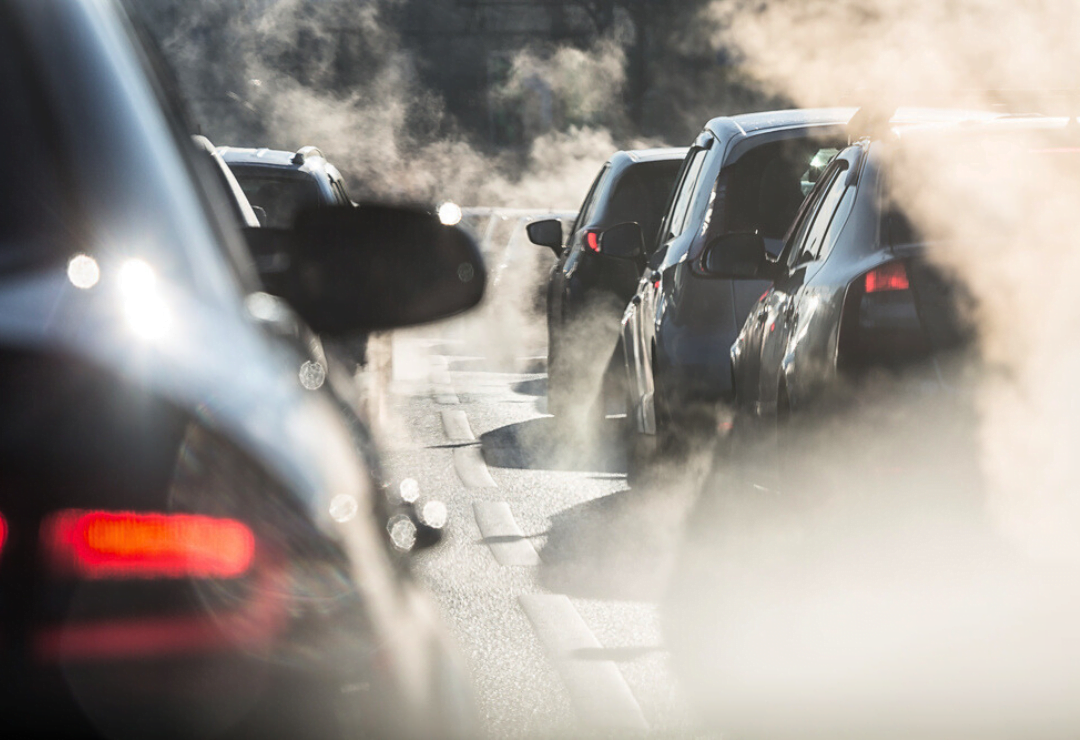Fighting for Clean Air
Air pollution remains the number one environmental health risk in Europe, and the current lack of alignment between Europe’s air quality standards and emissions standards for road vehicles is a major obstacle to ensuring a healthy living environment. POLIS explains why strong Euro 7 emission standards are not only feasible, but direly needed.
To listen to the recording of the article below, please accept all cookies.
In Europe, air pollution leads to frighteningly high levels of premature death every year. In 2020 alone, exposure to excessive air pollution caused an estimated 311,000 premature deaths in the 27 EU Member States (EU-27), making it Europe’s number one environmental health risk. These pollutants are linked to asthma, heart disease, and stroke.
Road transport-related emissions in particular are a primary culprit, accounting for an estimated public healthcare cost of more than 1,200 € per inhabitant per year.
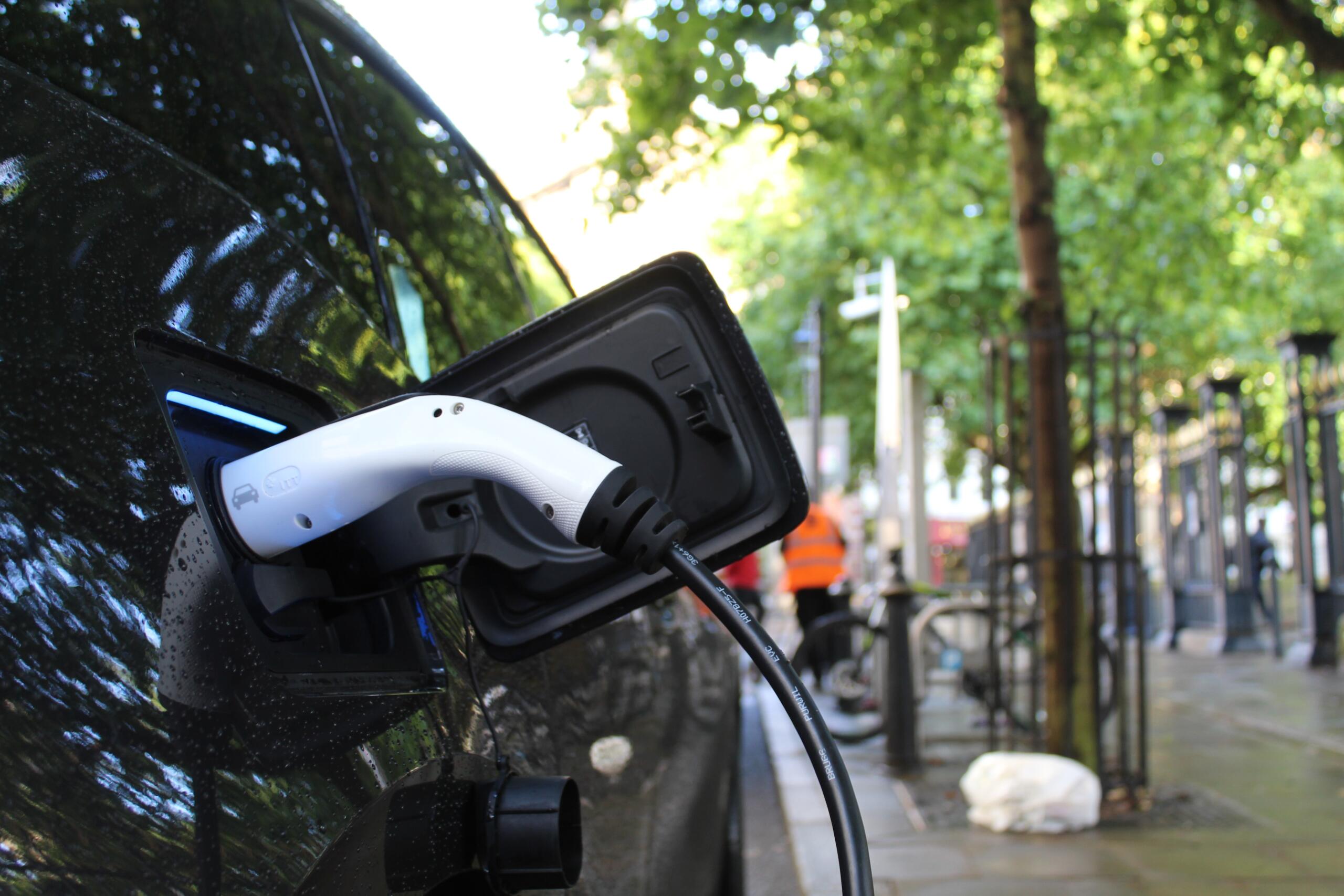
EV deployment in the EU is expected to increase substantially by 2030. Credit: Andrew Roberts, Unsplash
It is no coincidence, then, that NGOs and citizen groups are calling for drastic reductions in emissions from road vehicles with internal combustion engines (ICEs). Despite a promising future for electric vehicles (EVs) thanks to the EU’s ban on ICEs starting in 2035, the simple fact is that gasoline and diesel cars will not disappear overnight.
Indeed, they are likely to circulate on Europe's roads for decades after the 2035 cutoff given the average lifespan of today's vehicles. With the uptake of EVs proceeding at varying rates across the EU-27, countries on a slower track toward electrification will therefore also be the ones to suffer the most from lax restrictions on pollutant emissions.
Even with a swift transition, electromobility will not be the ‘silver bullet’ that will eliminate air pollution from cars. Although electric vehicles do not produce tailpipe emissions, they contribute to non-exhaust-related air pollution due to road and tire abrasion and brake wear. Moreover, electromobility alone will not reduce traffic congestion, nor will it necessarily improve road safety in urban areas.
Supporting cities at the EU level
Under the European Green Deal’s Zero Pollution Action Plan, the European Commission (EC) set a 2030 goal of limiting the number of premature deaths caused by particulate matter (PM) 2.5 by at least 55% compared with 2005 levels.
One of the key policy tools to achieve this reduction was the proposed revision of the Ambient Air Quality Directive (AAQD), aligning the air quality standards more closely with the recommendations of the World Health Organisation (WHO). This revision was long overdue and carries implications for more than just public health – it is also a call for greater social justice, as air pollution disproportionally affects Europe’s most socio-economically vulnerable citizens.

Air pollution has especially harmful impacts on vulnerable groups, such as newborns. Credit: AlyoshinE, Shutterstock
However, compliance with stricter air quality standards will bring added challenges for cities and regions. Even though urban air quality has been steadily increasing across Europe, safe pollution levels are still far off: in 2021, 97% of the urban population in the EU was exposed to concentrations of fine particulate matter above the health-based guideline level set by the WHO. This is particularly a concern in Southern and Eastern European cities.
Air pollution resulting from road transport can be tackled upstream, for example by reducing vehicle tailpipe emissions, or downstream, by establishing Urban Vehicle Access Regulations (UVAR) that either reduce the overall number of vehicles in circulation or put targeted restrictions on highly pollutant vehicles.
Some examples are Low and Zero Emission Zones (LEZ/ZEZ), low-traffic neighbourhoods (LTN), and congestion charging schemes. Both upstream and downstream measures should be a priority, however, they fall under the competencies of different authorities. Legislation that regulates pollutant emissions is mostly approved at the EU or national level, whereas access regulations are primarily within the jurisdiction of local or regional authorities.
To effectively curb air pollution, there should be an alignment between air quality standards and the policy tools that enable cities to meet those requirements (ie emissions regulations). In the absence of such an alignment, cities are left alone to adopt and implement the necessary (but not always popular) measures to curb air pollution.
Dwindling ambition for a strong Euro 7
A promise of change came in 2022 when the European Commission (EC) published its Euro 7 legislative proposal. In the proposal, the EC called for the EU to revive its rules for type-approval and market surveillance of motor vehicles by setting more stringent limits on pollutant emissions from road transport.
Despite the inclusion of several much-needed provisions, including extended durability requirements and limits on non-exhaust emissions from brakes and tires, the Euro 7 proposal has notable shortcomings. In particular, it fails to set stricter tailpipe emissions regulations for both light and heavy-duty vehicles. As such, it represents a missed opportunity to match the ambition of the revised AAQD.
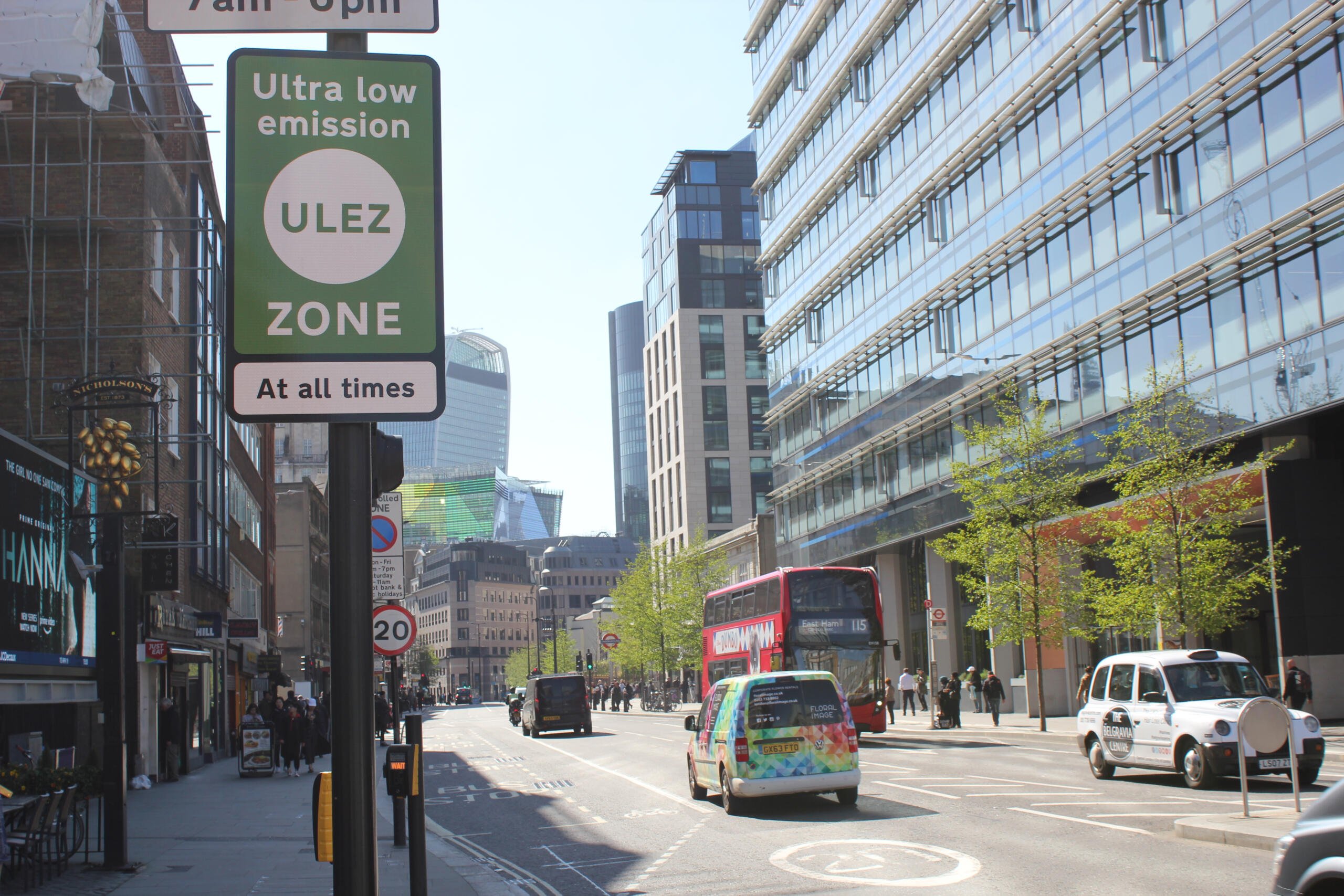
Street sign marks an ultra-low emission zone (ULEZ) in London. Credit: Lorna Roberts, Shutterstock
To add insult to injury, the Council of the EU reached an agreement on the Euro 7 proposal that further undermines its ambition. As many had feared, the Council opted to keep the current Euro 6 exhaust limits for light-duty vehicles and set lax restrictions on heavy-duty vehicles. Worse yet, the Council proposed a delay in the implementation of Euro 7, leaving Europe’s cities and regions to fight for cleaner air on their own in the meantime.
Unsurprisingly, the Council’s position was met with outrage from those who say that the EU is doing too little to curb pollution from cars. This was aptly expressed by EURACTIV’s Editor of Transport Sean Goulding Carroll, who wrote that in a ‘choice between economic strength or health,’ the Council decided to prioritise the economic interests of the automotive industry over the European public’s demands for a cleaner living environment.
For weeks after the Council announced its position, NGOs waited with bated breath, hoping for more ambition from the European Parliament (EP). Their wishes, however, went unanswered: the Parliamentary Committee on the Environment, Public Health and Food Safety (ENVI) revealed that Euro 7 would go forward in its watered-down form.
Among other things, ENVI set a longer timeline for the implementation of new emissions standards for heavy-duty vehicles and limited vehicle testing requirements.
Speaking for ENVI, Rapporteur Alexandr Vondra (CZ) of the European Conservatives and Reformists Group (ECR) said: ‘We have successfully struck a balance between environmental goals and the vital interests of manufacturers. It would be counterproductive to implement environmental policies that harm both Europe’s industry and its citizens.’ Needless to say, others saw things a bit differently.
NGOs speak up
This is not the first time that Euro 7 has cropped up in the debate on sustainable mobility, nor is likely to be the last. Ever since the EC’s initial proposal in November 2022, the future of Europe’s air quality regulations has hung in the balance, and more than one organisation has had something to say about it.
Benjamin Krieger, Secretary General of the European Association of Automotive Suppliers (CLEPA), remarked: ‘Latest stage Euro 6 vehicles perform well on pollutant emissions. Nevertheless, despite progress on e-mobility, the EU is projected to sell 100 million conventionally powered cars in the next decade and those need to be further improved. Euro 7 as the Commission proposed would have been technically and economically feasible with certain safeguards. Europe should not lag behind China and the US, who have both set ambitious targets on pollutant emissions.’
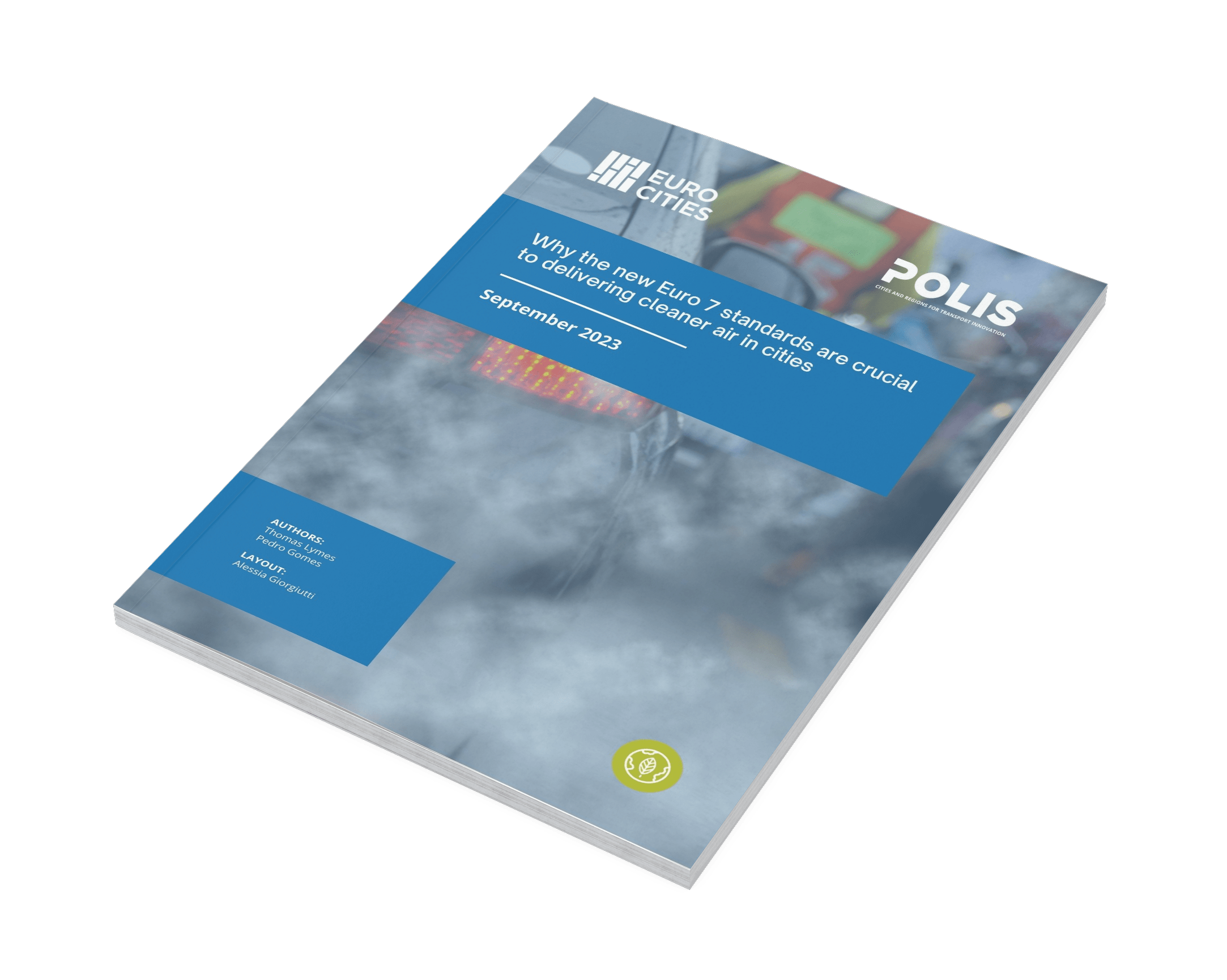
Euro 7 Joint Report – POLIS & Eurocities
Even before a decision had been made about the future of Euro 7, POLIS and Eurocities — two of Europe’s leading networks of cities and regions working toward sustainable mobility — had joined forces to pen a joint letter, demanding that the Euro 7 emission standards be reinforced.
When the Council’s decision arrived several months later, they released a follow-up report reminding policymakers of Euro 7’s importance and needed changes to the legislative proposal. Their report became all the more relevant when ENVI clarified its position in October, and when a coalition of European cities signed a petition asking the EP to reconsider the negative impacts of its decision for local authorities.
On behalf of their member, POLIS and Eurocities co-authored a report in September 2023, in which they made clear why an ambitious version of the Euro 7 proposal might be the EU’s best (and last) chance to prevent road transport-related air pollution from severely impacting public health.
They emphasised that vehicles with internal combustions engines (ICEs) will continue to circulate on European roads for decades to come, even after electric vehicles become the new status quo. Without better regulations at the EU level, they warned, today’s emissions will become tomorrow’s health crisis.
Backing the Clean Vehicles and Air Quality Working Group who co-authored the report, Secretary General of POLIS Karen Vancluysen said: ‘Our cities need fewer, but also cleaner cars. While electromobility is quickly becoming a reality in Europe, it is not a silver bullet. Without proper policy tools like an ambitious Euro 7 in place, cities and regions will not be able to properly safeguard the health of their citizens and their right to clean air — this remains a major health challenge.’
What is needed?
Despite the automotive industry’s complaints that stricter regulation would do little more than draw funding away from innovation in electric vehicles, strong Euro 7 standards are a must. Not only are they vital to achieving the 2030 goals of the European Green Deal’s zero pollution action plan, but they would also help bring the EU’s air quality standards in line with the 2021 recommendations of the World Health Organization (WHO).
While the European Parliament (EP) made progress to tighten the 2035 limits on air pollutants and harmonise air quality indices across the EU this September, these efforts are not enough on their own to address a major culprit: pollution from vehicles running on ICEs.
A comprehensive strategy that safeguards urban citizens’ right to clean air while holding the automotive industry accountable for the public’s health is yet to be achieved, and without it, the EU risks letting go of perhaps its greatest opportunity to combat road-traffic-related air pollution.
That is why the Clean Vehicles and Air Quality Working Group at POLIS, together with Eurocities, has set out in writing exactly what kind of Euro 7 standards citizens should expect:
1. Stricter limit values for pollutant emissions sufficient to meet the standards of the revised AAQD: When discussing air pollution, it is important to focus on regulated pollutants like carbon monoxide (C0), nitrogen dioxide (NO2), and particulate matter (PM), which pose a threat to human health. For many years, EU air quality standards have set high (ie lenient) limits on these pollutants. By allowing manufacturers to introduce more ICE vehicles to the European market that fail to meet the strict air quality standards recommended by the WHO, the EU is therefore prioritising the interests of the automotive industry over public health. Moving forward, the Euro 7 emission standards should be aligned with more ambitious air quality standards.
2. An EU-wide requirement for emissions testing conditions to match actual car usage in European cities: Lab testing conditions often fail to reflect the reality of car usage and driving behaviour in European cities. For example, they may not fully consider the effects of seasonal temperature differences or typical city driving profiles on the efficiency of mechanisms like after-treatment systems, which help to limit harmful exhaust emissions from ICE engines. Consequently, a vehicle that is compliant with EU emissions regulations (on paper, at least) may emit far more pollutant particles than expected when it hits European streets.
3. A longer period of validity for emissions restrictions on ICE vehicles to reflect their actual lifespans, including on the second-hand market: Another problem with existing restrictions on vehicle type approval is that they do not follow vehicles across their entire lifespan. While a vehicle may be up to standard when it is first introduced to the market, years of usage can hamper its efficiency, meaning that it could produce sub-standard levels of pollutant emissions at a later stage. This problem is particularly felt in second-hand markets, many of which are in Eastern Europe. To prevent Eastern European countries from becoming a dumping ground for highly pollutant vehicles, the EU must ensure that the Euro 7 emissions restrictions cover vehicles for the full duration of their usage, which may extend up to 15 years.
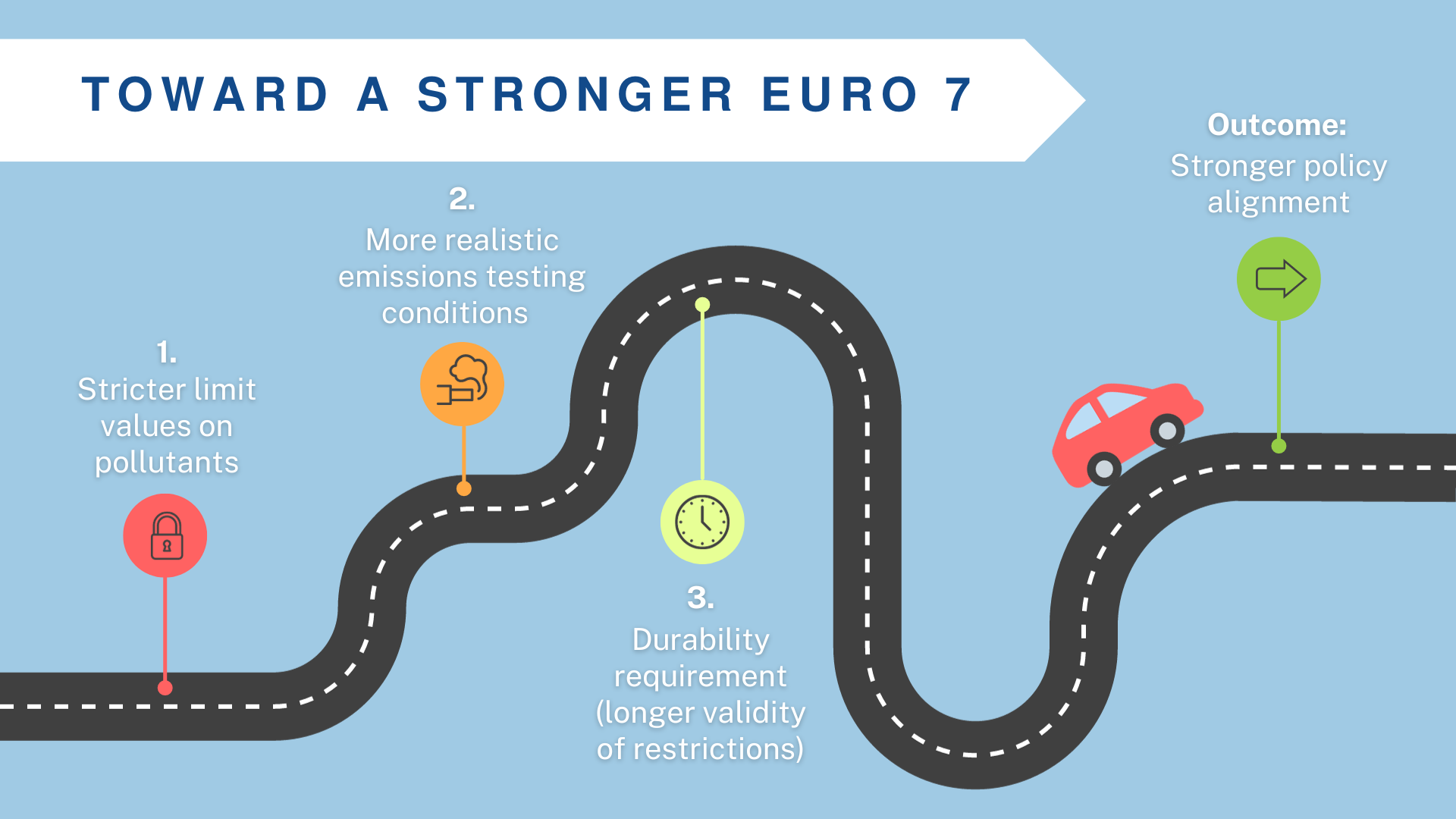
The roadmap to a better Euro 7 – Prepared by Quaid Cey
No air to waste
The window of opportunity to curb toxic emissions is growing smaller every day. To achieve cleaner air for citizens, Europe needs to establish a coherent policy framework for the mitigation of air pollution. The current legislation simply is not enough: major shortcomings include the lack of ambition on Euro 7 and the inclusion of e-fuels in the proposed CO2 standards of cars and vans.
While the direction of the Euro 7 standards appears every day less like that envisioned by POLIS and many other mobility stakeholders, citizens and their representatives must continue to advocate for change. Moving forward, one thing remains clear: stricter standards are not only technically and economically feasible — they are essential for public health.

NGOs in Brussels count on the EU to enact much-needed legislative changes. Credit: Christian Lue, Unsplash
Click here to read the article in its original format.
About the authors:
Quaid Cey is a Communications Assistant at POLIS. His responsibilities include producing news and social media content, promoting POLIS events and campaigns, and contributing to the publication of Cities in motion. He has a BA in Liberal Arts & Sciences from the University of Maastricht (UM) and an MA in Communication Studies from the Vrije Universiteit Brussel (VUB).
Pedro Gomes leads POLIS’ Clean Vehicles and Air Quality Cluster and manages several EU-funded projects, including APOLLO, CleanMobilEnergy, eCharge4Drivers, SOLUTIONSplus, and EAFO3.0. He holds an MSc in Environmental Management Systems and has experience conducting research on energy efficiency, GHG emission mitigation, and sustainable mobility.
